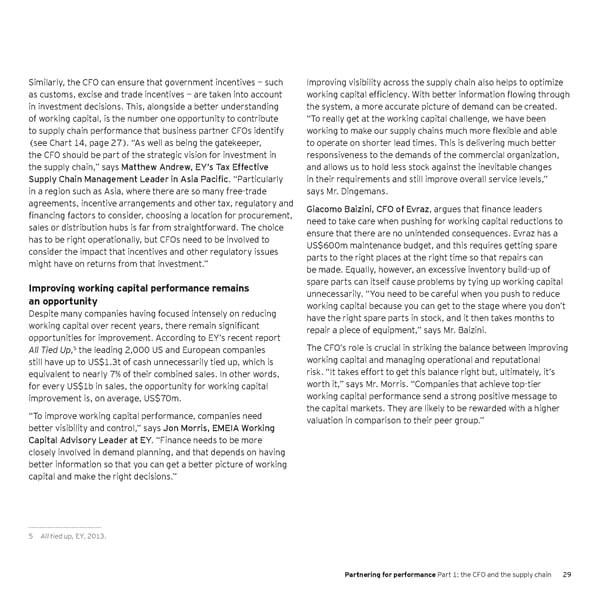Similarly, the CFO can ensure that government incentives — such Improving visibility across the supply chain also helps to optimize as customs, excise and trade incentives — are taken into account working capital efficiency. With better information flowing through in investment decisions . This, alongside a better understanding the system, a more accurate picture of demand can be created . of working capital, is the number one opportunity to contribute “To really get at the working capital challenge, we have been to supply chain performance that business partner CFOs identify working to make our supply chains much more flexible and able (see Chart 14, page 27). “As well as being the gatekeeper, to operate on shorter lead times . This is delivering much better the CFO should be part of the strategic vision for investment in responsiveness to the demands of the commercial organization, the supply chain,” says Matthew Andrew, EY’s Tax Effective and allows us to hold less stock against the inevitable changes Supply Chain Management Leader in Asia Pacific . “Particularly in their requirements and still improve overall service levels,” in a region such as Asia, where there are so many free-trade says Mr. Dingemans. agreements, incentive arrangements and other tax, regulatory and Giacomo Baizini, CFO of Evraz, argues that finance leaders financing factors to consider, choosing a location for procurement, need to take care when pushing for working capital reductions to sales or distribution hubs is far from straightforward . The choice ensure that there are no unintended consequences . Evraz has a has to be right operationally, but CFOs need to be involved to US$600m maintenance budget, and this requires getting spare consider the impact that incentives and other regulatory issues parts to the right places at the right time so that repairs can might have on returns from that investment .” be made. Equally, however, an excessive inventory build-up of Improving working capital performance remains spare parts can itself cause problems by tying up working capital an opportunity unnecessarily . “You need to be careful when you push to reduce working capital because you can get to the stage where you don’t Despite many companies having focused intensely on reducing have the right spare parts in stock, and it then takes months to working capital over recent years, there remain significant repair a piece of equipment,” says Mr . Baizini . opportunities for improvement . According to EY’s recent report 5 The CFO’s role is crucial in striking the balance between improving All Tied Up, the leading 2,000 US and European companies still have up to US$1 .3t of cash unnecessarily tied up, which is working capital and managing operational and reputational equivalent to nearly 7% of their combined sales. In other words, risk . “It takes effort to get this balance right but, ultimately, it’s for every US$1b in sales, the opportunity for working capital worth it,” says Mr. Morris. “Companies that achieve top-tier improvement is, on average, US$70m. working capital performance send a strong positive message to the capital markets . They are likely to be rewarded with a higher “To improve working capital performance, companies need valuation in comparison to their peer group .” better visibility and control,” says Jon Morris, EMEIA Working Capital Advisory Leader at EY . “Finance needs to be more closely involved in demand planning, and that depends on having better information so that you can get a better picture of working capital and make the right decisions .” 5 All tied up, EY, 2013. Partnering for performance Part 1: the CFO and the supply chain 29
 Partnering for Performance Part 1 Page 30 Page 32
Partnering for Performance Part 1 Page 30 Page 32